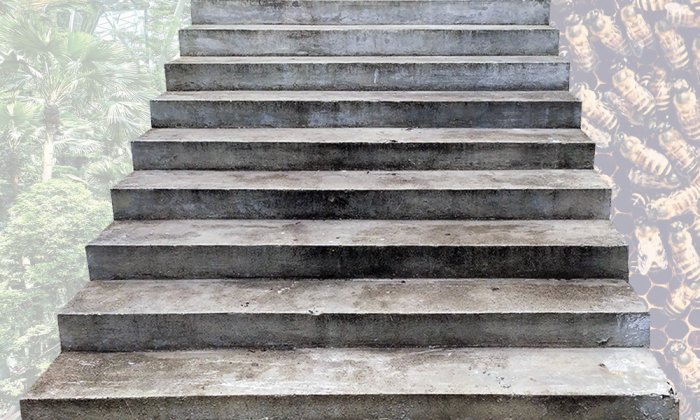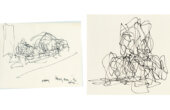Moshe Safdie: My Steps and Gardens and Bees

Everything about Haifa, the city of my birth, seemed to be about climbing steps. The city had originated on the shores of the Haifa-Acre Bay. Some years before my birth, the British built a modern port and the city began climbing the slopes of Mount Carmel. I was born in a Bauhaus-style apartment building abutting the Technion, the Institute of Technology, halfway up the mount. By the time I turned 10 we were elevated, in more than one sense, and lived in a building up the hill. It was a three-story building; the ground floor apartments opened to gardens below and mid-level apartments had side entrances. We lived on the top floor that we reached through a bridge from the mountainside. We also owned the roof of the building, which had an extraordinary view of the bay and the Lebanon Mountains.

One hundred and seventy-three steps led up the hill to the crest — Hadar Hacarmel, as it was known — the center of my school and social life. In the morning I would skip steps two at a time, rain or shine, to the crest. From there I would either pick up a bike or a bus to school. Returning in the afternoon, I perfected my run, skipping four stairs at a time, timing myself, hoping to break my own record.
Agricultural stone terraces built hundreds of years ago graduated the slopes. Steps abounded everywhere. The land surrounding our building was nearly vacant. As this was a time of austerity, we put the land to good use. Earth was turned (often revealing centipedes or scorpions), and we planted tomatoes, cucumbers, and sweet peas. We built a hen house from leftover wood cases to supply eggs for the family.
One spring day, returning from school, I reported with great excitement that I could bring home a beehive. Everyone was short on sugar and the beehive promised honey. My parents were skeptical, but it arrived and was placed on the roof. It consisted of a basic box, a family of bees with its queen, and a series of empty frames, each with a base sheet upon which the bees could construct their house of wax. I watched with amazement as the bees went to work. Week by week, they constructed their house of perfect geometry, a series of hexagons, all seemingly identical, rising in orderly fashion, filling frame after frame. As the bees worked, I read profusely. I learned that the hexagonal cells were not all alike. Some were slightly bigger; in those, male eggs would be raised. Other cells, once filled with honey, would be sealed. I observed the queen, moving from cell to cell, laying her eggs. I watched for the wax moth — the curse of bees. I felt witness to the construction of an entire city, panel by panel, neighborhood by neighborhood. Different cells were specialized in function. Some were for the storage of food, others for raising future workers and queens, and some for the useless males, useless that is, except when their services were urgently required. This happened when an old queen was replaced by a new one and she needed her once-in-a-lifetime impregnation.
I felt witness to the construction of an entire city, panel by panel, neighborhood by neighborhood.
Even for an 11-year-old, it was clear that this complex world was highly efficient. It exhibited a fitness to purpose that resulted in extraordinary beauty. I probably could not have articulated these words “fitness to purpose” until a decade later, when at age 22, by then an architect and apprentice in Louis Kahn’s office, I was devouring D’Arcy Thompson’s “On Growth and Form.” The memory of my bees made D’Arcy Thompson’s words more vivid. His studies of the lattice bone structure in the vulture’s wing, the logarithmic growth pattern of the nautilus shell, the efficient space packing of insects’ habitats, were enriched by my having the beehive as a reference point.
In Haifa you could move up or down the hill via steps everywhere, or you could move along the contours of the sloped surface. Five hundred meters to the west of my house was the world center of the Bahá’í religion, the burial place of the founder of Bahá’í.
There relatively arid terraced land that had sustained a few olives, cypresses, and carob trees, was transformed into a lush, green paradise garden. There was a sudden transition across a wrought iron fence that marked off a major estate of a hundred acres. Fashioned in the Persian garden tradition, adapted to the steep topography, there were monumental stairs made of white marble that ascended up and down the hill on its axis, that is, directly perpendicular to the slope, and a series of gently meandering paths, accentuated by long rows of cypress and palm trees. Some of the paths were paved with loose chips of red tiles, others with gray river pebbles, others yet with fine marble gravel. There were colorful paths cutting through flowerbeds, grass areas manicured to perfection, little round garden pavilions of white Corinthian columns and, always on axis, bronze peacocks whose oxidized dark castings were highlighted with gold leaf and silver. As I traversed the paths, I had the feeling that I was sinking into a carpet, my body size diminishing, living within the rich geometries of the familiar Persian carpets that every room in my parent’s house possessed.
I abhorred Bible class. Five years later, exiled to Canada, I would discover the Bible through an Anglican teacher at Westmont High School in Montreal when I studied the book of Job and immersed myself in its description of the paradoxes of life. But for now, I was convinced that the paradise garden of the first book of Genesis resembled my Bahá’í garden. As I walked through it, I would not have been surprised to come across Adam and Eve. There were certainly enough fig trees to supply the necessary attire.
In years to come, I had a recurring obsession in my work — I made buildings you could climb on, buildings that were gardens, gardens that were buildings, steps and gardens everywhere, even the title of my second book bears its trace, “For Everyone a Garden.”
In years to come, I had a recurring obsession in my work — I made buildings you could climb on, buildings that were gardens, gardens that were buildings.
By the time I was 14, my beehive had expanded. The one box had become two and then three, extending upwards in modular fashion. My family, unable to consume all the honey, shared it with relatives and neighbors. It was then that we received a new assignment in science class: to describe how energy is harnessed by making drawings and illustrations. Though I could draw with considerable ease, drawings seemed inadequate to describe what I had in mind. I joined with a friend and we decided to make a model. With a model, we could create a lake formed by a dam, show the water drop into turbines below, set windmills on the ridge, irrigate the terraces downhill, and so on. In the basement of a building that had been used as an air raid shelter during the Second World War, we found an old, unused door and used it as the base for our model. We purchased many pounds of clay to form hills, a lake, and valleys. We cut up little weeds to represent trees. We used dyes to color the landscape. We tried simulations by pouring water above and seeing it trickle downwards and we began searching for a pump that might keep the system going. We did all of this in a week of intensive work. We never attempted to move our model (nearly 4 × 7 feet in dimension) from our garden. By the time we had to bring it to school, it must have weighed a hundred pounds. Finally, with great effort, six of us tried to move it, ever anxious about cracking the clay. Eventually we hired a small truck, a transport arranged by proud parents, and our model was brought to school. Until then, I had been an indifferent student, at times flirting with expulsion. I had refused to do homework or comply with assignments. Now I was rising well above the call of duty.
I will never forget the excitement of making that first model. We had shaped the forms of the hills and streams. I felt like an extension of God’s hands, shaping the landscape to my will. I felt a sense of what might come: conceiving and shaping buildings and landscape, a design process dependent on making models.
Only a year later, my life was disrupted by my parents’ decision to immigrate to snowy, cold Montreal. I was on my way to a new world. Before we could leave for Canada, my family needed visas that could be issued only by the Consul General in Milan, Italy. The process took thirty days. To appease me and my brother and sister, all outraged by our enforced exile, my parents took us sightseeing: in Rome, there was the Forum, the Coliseum, the Vatican, and a place that transfixed me, Hadrian’s Villa. Soon we were in Milan, where the roof of the Duomo, with its flying buttresses and fantasyland sculpture, became our playground. There were excursions to Lake Maggiore and Lake Como, to the floating island palaces in the lake, and the terraced gardens of Stresa. Within two years, as I completed high school year in Montreal and prepared to apply to university, there was no question in my mind. I would apply to the school of architecture.
Moshe Safdie has an international architectural practice designing a wide range of building types, including housing, arts, civic, and cultural buildings on four continents. After graduating from McGill University, he apprenticed with Louis I. Kahn in Philadelphia. He realized Habitat ’67 at the 1967 World’s Fair in Montreal and played a major role in the rebuilding of Jerusalem. He has taught architecture at Harvard, Yale, McGill, and Ben-Gurion universities. This article is excerpted from the volume “Falling for Science: Objects in Mind,” edited by Sherry Turkle.



